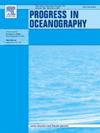Phytoplankton diversity and zooplankton diet across Fram Strait: Spatial patterns with implications for the future Arctic Ocean
IF 3.6
3区 地球科学
Q1 OCEANOGRAPHY
引用次数: 0
Abstract
The rapid transformations in the European sector of the Arctic Ocean, characterized by a pronounced increase in Atlantic water inflow and a decline in sea ice, are reshaping the trophic structures within this ecosystem. This study investigates the effects of such environmental changes on the planktonic trophodynamics in Fram Strait, focusing on the comparison between Arctic and Atlantic influenced regions. Utilizing a combination of fatty acid and stable isotope biomarker analyses, we analyze the dietary composition and trophic levels of key zooplankton species, including Arctic and boreal-Atlantic sister species of Calanus, Paraeuchaeta and Themisto. The findings reveal significant differences in the dietary structures between the different areas in Fram Strait. In the Arctic region, the diet of zooplankton species is primarily influenced by diatoms, as indicated by the dominance of diatom-specific fatty acid trophic markers. Conversely, the Atlantic region exhibits a different dietary pattern, pointing to a reduced influence of diatoms and increased importance of (dino-)flagellates for Calanus spp., as well as a higher degree of carnivory in higher trophic levels. Moreover, the comparison of sister species unveils a distinct overlap in dietary niches between congeners of Calanus and Paraeuchaeta, highlighting the increasing potential for competitive interactions as Atlantification progresses. These results underscore the complex relationships within Arctic food webs and the profound impact of environmental changes on trophodynamics. They also emphasize the importance of considering physiological adaptability, life history traits and ecological interactions in predicting the future of Arctic marine ecosystems amidst ongoing climate change.

海峡两岸浮游植物多样性和浮游动物饮食:空间格局对未来北冰洋的影响
北冰洋欧洲部分的快速变化以大西洋海水流入量明显增加和海冰减少为特征,正在重塑这一生态系统的营养结构。本研究调查了这种环境变化对弗拉姆海峡浮游生物营养动力学的影响,重点是北极和大西洋影响区域的比较。我们综合利用脂肪酸和稳定同位素生物标记分析,分析了主要浮游动物物种的食物组成和营养级,包括北极和北方-大西洋的姊妹物种 Calanus、Paraaeuchaeta 和 Themisto。研究结果表明,弗拉姆海峡不同地区的浮游动物食物结构存在明显差异。在北极地区,浮游动物物种的食物主要受硅藻的影响,硅藻特有的脂肪酸营养标记占主导地位就说明了这一点。相反,大西洋地区表现出不同的食物模式,表明硅藻的影响减弱,而(恐龙)鞭毛虫对 Calanus 属的重要性增加,同时在较高营养级中肉食程度较高。此外,姊妹物种的比较还揭示了Calanus属和Paraaeuchaeta属同源种之间在食物龛位上的明显重叠,这突出表明随着亚特兰蒂斯化的进展,竞争性相互作用的可能性越来越大。这些结果强调了北极食物网内部的复杂关系以及环境变化对营养动力学的深刻影响。它们还强调了在预测北极海洋生态系统在持续气候变化中的未来时,考虑生理适应性、生活史特征和生态相互作用的重要性。
本文章由计算机程序翻译,如有差异,请以英文原文为准。
求助全文
约1分钟内获得全文
求助全文
来源期刊

Progress in Oceanography
地学-海洋学
CiteScore
7.20
自引率
4.90%
发文量
138
审稿时长
3 months
期刊介绍:
Progress in Oceanography publishes the longer, more comprehensive papers that most oceanographers feel are necessary, on occasion, to do justice to their work. Contributions are generally either a review of an aspect of oceanography or a treatise on an expanding oceanographic subject. The articles cover the entire spectrum of disciplines within the science of oceanography. Occasionally volumes are devoted to collections of papers and conference proceedings of exceptional interest. Essential reading for all oceanographers.
 求助内容:
求助内容: 应助结果提醒方式:
应助结果提醒方式:


